|
|
Rabelais

|
|
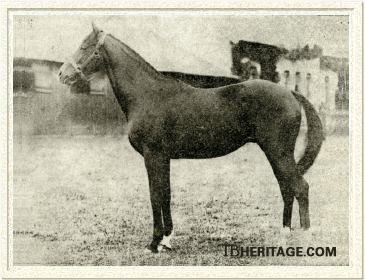 |
|
|
Of all the sons of St. Simon, it is Rabelais whose influence has persisted through the decades since his birth. He was not as fashionably bred as the classic-winning brothers Persimmon and Diamond Jubilee, or even Chaucer or Desmond, who were both out of classic winners. In racing class, he was a notch or two below classic standard. Yet his line persisted, generation after generation, with important and useful stallions, such as Ribot, Alleged, and Graustark.
Rabelais was foaled in 1900, the same year as Chaucer, another son of St. Simon who would exert an important breeding influence. Chaucer was better bred, being out of the classic winning-filly Canterbury Pilgrim, but Rabelais was the better performer on the track.
Rabelais was bred by Arthur James at the Coton House Stud near Rugby. The dam, Satirical, had displayed good class in her winning performances on the turf. When selecting a mate for her, James cashed in on a family connection. His wife was a daughter of George Cavendish-Bentinck, a former conservative member of Parliament and sportsman who was related to William Cavendish-Bentinck, the 6th Duke of Portland the owner of St. Simon.
Satirical's St. Simon colt was a handsome specimen, a bay with three white feet. While he had much to recommend him as a son of St. Simon, Rabelais had little on his dam's side. Though she had been a good winner, her family was hardly bred in the purple. Her sire, Satiety, though a son of Isonomy, had little of his sire's racing or siring talent, accounting for the Windsor Castle Stakes during his racing career and becoming only an average sire at best when he went to stud.
Satirical hailed from the family of Pasquinade, a full sister to Touchstone and Launcelot. Pasquinade's family had produced some notable performers over the years, but they were few and far between and scattered in different parts of the world. They included Deutsches Derby winner Peter; Espina and Porrazo, classic winners in Argentina; Lonsdale and Palmer, stakes winners in Australia; and Game Chick, winner of the Dewhurst and Champagne Stakes in 1901 when Rabelais was a yearling.
Mr. James named Satirical's son Rabelais, after Francois Rabelais, the sixteenth century French physician and writer whose works were brilliant satires of the social and political events of his time. Rabelais the horse was retained by Mr. James to race and sent to the Newmarket yard of trainer Richard Marsh.
Rabelais on the Turf
Rabelais made his racecourse debut under Danny Maher in the Sandown Park Stud Stakes in April of his two-year-old year, and finished a good second to Our Lassie, destined to win the next season's Oaks. Rested until the Ascot meeting in the middle of June, Rabelais took the five furlong Triennial Stakes by six lengths. A month later, in the National Breeders' Produce Stakes at Sandown Park, Rabelais had a sterner test to emerge victorious, edging an Orion filly later named Fledge. A fortnight later, Rabelais took the Prince of Wales's Stakes at Goodwood by three parts of a length over the beautifully bred filly Skyscraper, a daughter of classic champions Ayrshire and Chelandry. Rabelais closed out his juvenile season with an easy victory over one opponent in the Buckenham Stakes at Newmarket at the end of September.
The crop of 1900 also included Rock Sand, and as a juvenile, he lost only once in seven starts. He only got better at three, and easily took the Two Thousand Guineas, with Rabelais finishing a respectable third to Rock Sand and Flotsam III, with Chaucer, a two-time stakes winner at two, unplaced. Rabelais was second to Flotsam III in the Newmarket Stakes, a prep for the Derby at Epsom. Rabelais was not up to the task in the Derby, finishing fourth to Rock Sand, Vinicus, and Flotsam III.
Rabelais went from Epsom to Ascot for a victory in the Triennial Stakes. An unplaced run in the St. George Stakes at Liverpool was disappointing, yet he rebounded to land the prestigious Goodwood Cup over older horses at the end of July. The Goodwood Cup proved to be the final start for Rabelais. He left the track with six wins from eleven starts, being only twice unplaced.
Rabelais in the Stud
Owner James decided not to keep Rabelais for stud, and instead sold him. It was intended for Rabelais to be sold to Russian interests, but the sale was never finalized. Instead, he was sold to Count Jean de Nicolay and Michel de Gheest, proprietors of Haras de Montfort in France, serving his first stud season in 1905. For a good racing son of St. Simon, the sales price was a bargain, for Rabelais was sold for a reported price of 700 guineas, or $3500. Rabelais became a pronounced success in his adopted country, leading the French sire list three times, in 1909, 1919, and 1926.
|
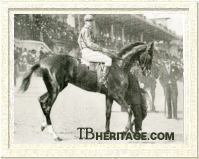
Verdun
| |
Rabelais was hot right from the start, with a star in his first crop. This was VERDUN, foaled in 1906 from the Gournay mare Vellena. Bred by Monsieurs de Nicolay and de Gheest, Verdun was sold as a yearling for 20,500 francs to Maurice de Rothschild. As a juvenile, Verdun took the Prix Heaume and was second to Oversight in the Prix de la Salamandre. Among his wins at three were the Poule d'Essai des Poulains, Grand Prix de Saint-Cloud, Prix du Président de la République, and Grand Prix de Paris. He was fourth to Negofol in the Prix du Jockey Club, and was retired after a poor showing in the Prix Royal-Oak.
|
Verdun stood stud for a time in his native France, and in 1917 was exported to Argentina, where he did very well, ranking as high as fourth on the Argentine general sire list in 1923. While in France, he sired many winners, among them Soldat de Verdun, who was exported to North America where he took the Windsor Hotel Cup in Canada over J.K.L. Ross's highly-esteemed filly Milkmaid. One of his best sired in Argentina was Barranquero, whose wins included the Premio Comparacion. However, Verdun's most important offspring was probably is daughter. Astrella, for she became the dam of Astérus, winner of the Poule d' Essai des Poulains and Prix Greffulhe in France and the Champion Stakes in England. Astérus proved even better at stud, leading the French sire list in 1934 and leading the list of French broodmare sires six years in succession, from 1943-1948. Among his best on the track was Adargatis, heroine of the Prix de Diane, and among his best producing daughters was Astronomie, dam of four top class stakes winners, Marsyas, Caracalla, Arbar, and Oaks winner Asmena.
Verdun's year-younger full sister VELLICA captured the Poule d'Essai des Pouliches in 1910. She had no recorded produce.
|
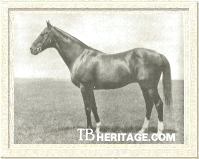
Rire Aux Larmes
| |
In 1907 came RIRE AUX LARMES, produced from Le Sancy's daughter Weeping Willow. Owned by Xenophon Balli, Rire aux Larmes was mediocre at ages two and three, but blossomed as an older horse, taking the Coupe d'Or and Grosser Preis von Baden-Baden and at least four other stakes. At stud in France and later in the United States, where he stood in Maryland. he was not a pronounced success, coming up with only two really top class animals: Losir, winner of the Prix du Conseil Municipal, and Take My Tip, winner of the Grand Prix de Paris.
|
Herman P. Duryea, an American horseman living and breeding racehorses in France after anti-betting legislation in the United States made it unprofitable to breed and race for a number of years, was partial to the blood of Rabelais, and by sending his mare Armenia to him, got the fine colt DURBAR, foaled in 1911. Durbar was unable to win in four starts at two in 1913, his best finish being a third in his last race of the season in the Prix Prestige. He was much improved at three, winning four of six starts before Duryea sent him across the English Channel to contest the Derby, which he won, becoming the first French-bred horse to land the Derby since Gladiateur in 1865.
|
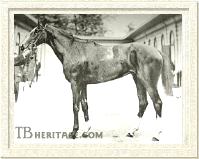
Durbar
| |
The Derby was the highlight of his racing career, as back in France, Durbar was badly beaten by champion Sardanapale in both the Prix du Jockey Club and Grand Prix de Paris. He was retired following the Grand Prix, entering stud in 1915. Durbar's stud career was markedly successful, and his daughters, in particular, were gems on the track and at stud.
|
Durbar's daughter Flambette was purchased by American Woodward and imported to the United States as a yearling in 1919. She won the Coaching Club American Oaks and Latonia Oaks, and as a broodmare, produced three stakes winners and was second dam of Triple Crown winner Omaha; Kentucky Derby and Belmont Stakes winner Johnstown; and champion fillies Jacola and Gallorette. Durbar's daughter Durban was a high class filly, taking the Grand Criterium and Prix Vermeille. She produced Prix du Jockey Club winner and three-time leading French sire Tourbillon. Durban's younger full sister Heldifann was a stakes winner and became ancestress of Priam, Djeddah, Corejada, and Appollonia, all top notch performers. In the mid-1920s Durbar was sent to stud in the U.S., where he got only two minor stakes winners before his death in 1932.
Rabelais sired NATURALIST from Meddler's daughter Nature. Foaled in 1914, Naturalist was an evil-tempered animal and was gelded. He was sold to American Joseph E. Widener and sent to America, where he became a very talented stakes performer, winning the Toboggan Handicap, the Carter Handicap and the Manhattan Handicap twice. His full sister, CARNATION, foaled in 1921, remained in France for her racing career, and took laurels in the Prix la Rochette, Critérium des Maissons-Laffitte, and Poule d'Essai des Pouliches. She, too, was imported to the United States by Widener, and as a broodmare, was disappointing, failing to come up with anything near her own class.
PENDENNIS, out of Confection, by Isinglass, was a foal of 1917. As a three-year-old, he was victorious in the classic Poule d'Essai des Poulains. He made his stud career in Argentina. RAMUS, produced by the Son o' Mine mare Only One, came along in 1919. He raced for Marcel Boussac and in 1922, became the first Prix du Jockey Club winner campaigned by Boussac. He made an indifferent sire, but was broodmare sire of the good stakes winner Adrar.
|
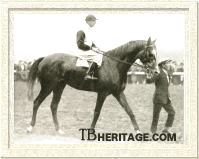
Biribi
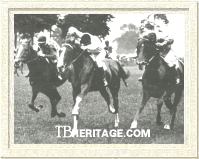
The blaze-faced Rialto (center) was beaten by a head by the top filly Dorina (right) in the Prix de Vineuil
| |
Rabelais seemed to lose little as he aged, for the 1923 crop, foaled when he was twenty-three, contained two exceptional colts. They were BIRIBI and RIALTO. The former, a gray out of La Bidouze, by Chouberski, took the Prix de l'Arc de Triomphe, Prix Royal-Oak, Prix Noailles and placed in the Prix du Jockey Club and Grand Prix de Paris, and Prix du Président de la République as a three-year-old . At four, he took the Prix des Sablons. Biribi proved an exceptional stallion. His daughter Perruche Bleu was victorious in the Prix de Diane. he sired two winners of the Poule d'Essai des Pouliches in Bipearl and Colette Baudoche. His son Birikil took laurels in the Criterium de Maissons-Laffitte, Prix Eclipse, and Grand Prix de Deauville. Birikil was confiscated by the Germans during World War II, and there won six races. He was returned to France after the war, and during the 1950s served stud in both Argentina and Brazil.
Biribi's most outstanding representative was undoubtedly Le Pacha, undefeated during his three-year-old season in 1941 in occupied France, his victories including the Prix du Jockey Club, Prix Royal-Oak, Prix de l'Arc de Triomphe, and Grand Prix de Paris. Le Pacha sired many useful winners, his best being Marco Polo, a multiple stakes winner in Britain and later a successful sire in Australia.
|
RIALTO was not a classic winner, but a good horse nonetheless, capturing the Prix d'Ispahan and placing second in the Prix de l'Arc de Triomphe. He was an important stallion, siring, among others, the major winners Sanguinetto and Wild Risk. Rialto's best winners were Hern the Hunter, winner of the Prix du Cadran and Prix Hocquart and third in the Prix du Jockey Club; La Belle du Canet, victress in the Prix Vermeille and Prix Chloe and second in both the Poule d'Essai des Pouliches and Prix de Diane; and Sanguinetto, victor in the Prix d'Ispahan and Prix du Conseil Municipal. Son Eros took the Prix Edgard Gillois; sons Houdon and gelded Rabirus took the Grand Prix d'Automne and two editions of the Grand Handicap du Tramblay, respectively. Saranak, another gelding, was a stakes winner over jumps.
Rialto's son Wild Risk, was a good stakes winner on the flat, his wins including a score in the Prix Edgard Gillois, and he also won some races over jumps. At stud, Wild Risk was responsible for Balto, a high class stayer who pulled off the Ascot Gold Cup--Grand Prix de Paris double; Waldmeister, winner of the Prix du Cadran and later a leading sire in Brazil; Worden, winner of the Prix du Conseil Municipal and Washington D.C. International; and Le Fabuleux, winner of the Prix du Jockey Club and a prominent sire in both France and the United States. Then there was Rialto's daughter Sif.
A two-time stakes winner at three in France, Sif was an outstanding broodmare. From nine foals, she produced four stakes winners, including the full Prince Bio siblings Senones and Sicambre. The latter was a star on both the racecourse and the breeding shed. His resume included scores in the Grand Criterium, Prix de Guiche, Prix Greffulhe, Prix Hocquart, Prix du Jockey Club, and Grand Prix de Paris. At stud, Sicambre had the distinction of siring classic winners in four countries: Ambergris, winner of the Irish Oaks; Sicarelle, heroine of the English counterpart; Belle Sicambre and Hermières, winners of the Prix de Diane; and Celtic Ash, winner of the Belmont Stakes. Champion Roi Dagobert, Grand Prix de Paris winner Phaeton, and Washington D.C. International chapion Diatome were also sired by Sicambre.
Rialto had a full sister, ROAHOUGA, two years his junior, who was a victress in the Poule d' Essai des Pouliches. She failed to produce anything of high class. Her son, Corona, served stud in Colombia with little fanfare.
|
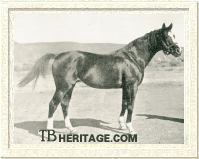
Fenimore Cooper
| |
FENIMORE COOPER, foaled in 1924, was produced from the Meddler mare Fireplay and was from the immediate family of English Derby winner St. Blaise. Bred by Monsieurs de Nicolay and de Gheest, Fenimore Cooper was sold as a yearling to Mariques de Llano for 225,000 francs, making him the eighth most expensive yearling of his crop in France. He justified his purchase price by winning the Criterium de Maissons-Laffitte at two and the Prix Noailles at three. He also ran good, albeit losing efforts, in the Prix du Jockey Club and Grand Prix de Paris. Fenimore Cooper was extremely versatile, precocious enough to win stakes at two, with enough stamina to win over nineteen furlongs, which he did at age five. He also placed in a couple of races over jumps.
|
Following is racing career, FENIMORE COOPER was purchased by E. Kelley Patterson, master of Temple Stud in South Africa, remaining in that country until his death in 1947. Fenimore Cooper proved a decent sire, his son Hunting Ground capturing the South African Derby Stakes and his daughter Preston Pan taking the South African Guineas. Fenimore Cooper's daughter, Prairie Flower, produced the noted runners Coyote and Cape Heath, the latter a winner of the South African Derby Stakes.
The most influential son of Rabelais, however, was HAVRESAC II. Out of Hors Concours, by Ajax, he was foaled in 1915. Though bred in France, Havresac II raced in Italy, where he won nine of fifteen starts, including the Premio Ambrosiano. His pedigree made him an interesting stallion prospect, as he was inbred 2 x 3 to St. Simon and carried four crosses of St. Simon's sire Galopin in the first five removes of his pedigree. Havresac II led the Italian sire list a total of eleven times. He sired three winners of the Derby Italiano; four winners of the Premio Oaks d'Italia; two winners of the Premio Regina Elena (Italian One Thousand Guineas); and two winners of the Gran Premio del Jockey Club.
|
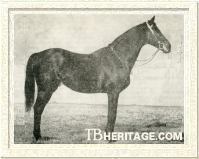
Havresac II, his sire line is still active today
| |
Leading Italian breeder Federico Tesio had good luck when sending his mares to Havresac II. When he sent his Cicero mare Chuette to him, he got the unbeaten Cavaliere d'Arpino, winner of the Gran Premio di Milano and Premio Ambrosiano and at stud, a stallion of near equal quality of his sire, coming up with two Derby Italiano winners, one winner each of the Premio Oaks d'Italia and Premio Regina Elena, and three winners of the Gran Premio del Jockey Club. One of Cavaliere d'Arpino's sons, Derby Italiano and Gran Premio del Jockey Club winner Bellini sired another Derby Italiano winner in Tenerani, and he in turn kept the male line going by siring possibly the best horse ever bred by Tesio, the undefeated champion Ribot. From Ribot have come Arts and Letters, Ribero, Boucher, Ragusa, Ribofilio, Ribocco, as well as His Majesty, Graustark, and Tom Rolfe, each an important sire.
|
Havresac II's daughter Nogara, foaled in 1928, was a champion on the racetrack, her victories including the Criterium Nazionale and Premio Regina Elena. As a broodmare for Federico Tesio, she was a producer of the highest class, becoming the dam of seven stakes winners, including unbeaten champion and influential sire Nearco; Premio Oaks d'Italia winner Nervesa; and Derby Italiano winner Niccollo Dellarca.
As a sire of broodmares, Rabelais was not as successful. His daughter MEDORA II was winless on the racetrack and was imported to the United States. She was a prolific producer of stakes winners, becoming the dam of six, including 1922 Travers Stakes winner Little Chief. BALANCE, out of the Meddler mare Balancoire II, was foaled in America in 1919. Her dam had been imported to the United States by the Whitney family and became a top flight producer for them. Balance was unraced, and as a broodmare is famed as the second dam of American champion Seabiscuit. Her family eventually included Kentucky Oaks victress Hail to Patsy; Kentucky Derby winner Determine; and champion filly Berlo.
Rabelais died in November of 1928. The 28-year-old stallion was still actively covering mares, but with his advanced age, both his libido and virility were compromised. Not content to let the old stallion be pensioned to live out his days in peaceful retirement, his owners subjected the horse to an operation of "gland grafting." Rabelais was sent to the veterinary school at Alfort, and the operation was performed by Professor Serge Voronoff, who had become famous in the 1920s for grafting the testicular tissue of executed criminals onto his patients. Later, as the technique became more popular and the number of cadavers was not sufficient, Professor Voronoff refined the operation by using the testicular tissue of monkeys. The operation on Rabelais, presumably with testicular tissue from a younger "donor" horse, was done in the hopes of improving the horse's fertility. Voronoff believed that by grafting the tissue of younger animals onto older ones, it would improve the fertility and libido of the older animal. Though Rabelais came out of the operation seemingly fine, he was dead only two days later from "pulmonary congestion." It was a sad end to St. Simon's most influential son.
--Elizabeth Martiniak
|
|
|
|

